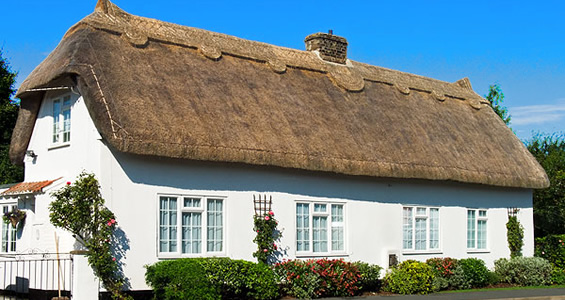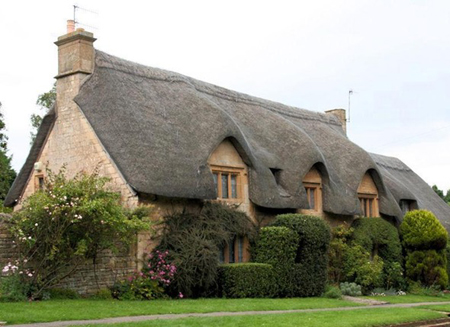Thatch roofing
Contents |
[edit] Introduction
Thatch roofing is a traditional roofing method that involves using dry vegetation such as straw, water reed, rushes, sedge, and so on to create a roof covering.
Thatch is still used in some equatorial countries, such as in Fiji where palm leaves are used, Dominica with feathered palm leaf roots, and Kenya with sugar cane leaf roots. In developed countries, thatch roofing has started to become more popular again, as a conscious design choice because of its aesthetics and for its ecologically-friendly credentials as a sustainable material.
The material composition of thatch, with its natural voids and surface irregularities, provides excellent insulation when dry and compact. However, when degraded with an accumulation of moss and rainwater, the insulation properties are less reliable. Thatch can also be vulnerable to fire.
[edit] History of thatch roofing
Thatched buildings were very common with indigenous peoples such as the Maya, Inca and Aztecs. Across Europe too, wild vegetation was used to cover shelters and primitive dwellings. Straw is believed to have been used as a roofing material in the Neolithic period when cereal agriculture began to develop.
In some parts of the UK, thatch was the only commonly-available roofing material until the late-1800s, when the commercial production of slate began, and the new network of canals and railways, made other materials more viable. The use of thatch began to decline towards the end of the 19th century because of the agricultural recession and the urbanisation of previously rural people.
The most common type of thatching material used in the UK was straw, either longstraw or combed wheat reed. Water reed was used in wetland areas such as the counties of East Anglia. This led to a diversity of styles, with different types of roof being characterised by the type of thatch. For example, combed wheat reed roofs are shallow pitched, whereas longstraw roofs are more steeply pitched.
[edit] Water reed
This is the most durable of the thatching materials, with a life expectancy of around 50-60 years. When re-thatching with water reed, new reed is fixed directly onto the rafters, starting at eaves level, with the butts of the stalks exposed. Steel or hazel sways hold each layer of reed in place. A legget is then used to dress the thatch into shape.
[edit] Longstraw
Longstraw must be made into yealms before it can be used for thatching. A yealm is a tight, compact layer or straw which is level at both ends. This straightens and tidies the straw, making it manageable for thatching.
When re-thatching with longstraw, existing material will usually only be removed back to a base coat, before the new straw is fixed using hazel spars. Netting is usually fitted to the whole roof as longstraw is more susceptible to attack from birds.
[edit] Combed wheat reed
Although similar to water reed, this is a type of straw which has had the grain removed using a combing machine. Applying combed wheat reed is similar to water reed, however, the existing material from the roof doesn’t necessarily all have to be removed.
[edit] Ridges
The ridge of a thatched roof must be carefully maintained every 10-or-so years, as the fixings are external. The two main types of ridge are as follows:
- The ‘wrap-over’: Formed by folding a thick layer of material over the roof apex and fixing on both sides.
- The ‘butt-up’: Formed by forcing the butts of the material together from either side to form an apex.
[edit] Performance
The performance of a thatched roof depends on the roof shape and design, the pitch, the location of the building (in terms of weather conditions), the quality of the material, and the skill of the thatcher.
The natural properties of thatch have a number of benefits:
- It is naturally weather-resistant.
- It does not absorb a lot of water when properly maintained.
- A roof pitch of at least 50-degrees allows precipitation to run off quickly.
- It is a natural insulator, with air pockets that insulate well in both warm and cold weather.
- When applied correctly, thatch has very good wind resistance.
- Thatch is relatively light, meaning that less timber is required in the roof structure.
- It is a versatile material when it comes to covering irregular roof shapes.
However, there is the perception that thatch roofing is at a higher risk of fire, meaning that thatched houses are harder to insure. Thatched roofs can also be more expensive than other coverings, and costly damage can be caused by birds, rodents and insects.
NB The main recommendation of guidance on preventing fires in thatched properties is that wood-burning and multi-fuel stoves should not be used in thatch-roofed buildings. For more information see: Thatched properties and wood-burning stoves.
[edit] Related articles on Designing Buildings Wiki
- Cottage.
- Domestic roofs.
- Green roofs.
- Metal composite panels.
- Shingle roofing.
- Re-thatching a Hebridean blackhouse.
- Roof coverings.
- Roof slates.
- Roof tiles.
- Roofing defects.
- Straw bale construction.
- Thatched properties and wood-burning stoves.
- The architecture of the Isle of Man.
- The Scots reed thatching tradition.
- Traditional straw thatching in times of shortage.
- Types of roof.
- Vernacular architecture.
[edit] External resources
Featured articles and news
A change to adoptive architecture
Effects of global weather warming on architectural detailing, material choice and human interaction.
How big is the problem and what can we do to mitigate the effects?
Overheating guidance and tools for building designers
A number of cool guides to help with the heat.
The UK's Modern Industrial Strategy: A 10 year plan
Previous consultation criticism, current key elements and general support with some persisting reservations.
Building Safety Regulator reforms
New roles, new staff and a new fast track service pave the way for a single construction regulator.
Architectural Technologist CPDs and Communications
CIAT CPD… and how you can do it!
Cooling centres and cool spaces
Managing extreme heat in cities by directing the public to places for heat stress relief and water sources.
Winter gardens: A brief history and warm variations
Extending the season with glass in different forms and terms.
Restoring Great Yarmouth's Winter Gardens
Transforming one of the least sustainable constructions imaginable.
Construction Skills Mission Board launch sector drive
Newly formed government and industry collaboration set strategy for recruiting an additional 100,000 construction workers a year.
New Architects Code comes into effect in September 2025
ARB Architects Code of Conduct and Practice available with ongoing consultation regarding guidance.
Welsh Skills Body (Medr) launches ambitious plan
The new skills body brings together funding and regulation of tertiary education and research for the devolved nation.
Paul Gandy FCIOB announced as next CIOB President
Former Tilbury Douglas CEO takes helm.
UK Infrastructure: A 10 Year Strategy. In brief with reactions
With the National Infrastructure and Service Transformation Authority (NISTA).
Ebenezer Howard: inventor of the garden city. Book review.
Airtightness Topic Guide BSRIA TG 27/2025
Explaining the basics of airtightness, what it is, why it's important, when it's required and how it's carried out.























